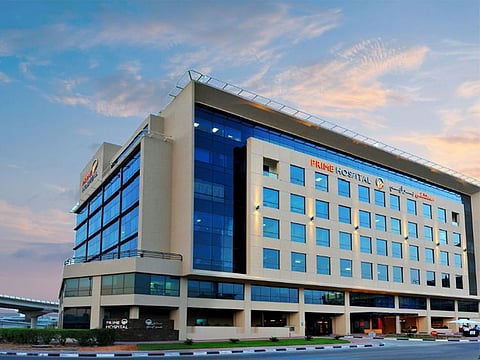Protect your heart by conducting vital heart screening tests
Prime Hospital offers a range of heart screening tests

Highlight
The Cardiac Sciences Department at PRIME Hospital and Medical Centers is home to a team of accomplished cardiologists and interventional cardiologists who provide exceptional round-the clock care to patients
Did you know that the global incidence of cardiovascular disease (CVD) is currently increasing? CVD stands as the leading cause of death worldwide. In the United Arab Emirates (UAE), it accounts for nearly 40% of annual mortality.
CVD is influenced by multiple risk factors, including high cholesterol, a history of Type II diabetes, hypertension, and regular smoking. It’s crucial to ensure your arteries remain healthy and free from silent plaque buildup.
At Prime Hospital, we offer a range of heart screening tests. A timely scan could save your life. Explore our available procedures and consult your cardiologist to determine which one is right for you.
Angiography
An angiography is a procedure that’s used to check the health of your blood vessels and determine how blood flows through them. It can help to diagnose several problems including atherosclerosis or narrowing of the arteries; peripheral arterial disease; brain aneurysm; angina; blood clots or a pulmonary embolism; and blockage in the blood supply to your kidneys. During this procedure, a small puncture is made into one of your arteries using a small gauge needle. A catheter is inserted into it and guided to the area that’s being examined. A contrast dye is injected into the tube and a series of X-rays are taken.
Angioplasty
This is a procedure used to open blocked arteries, whether it’s in your leg, brain or heart. Angioplasty when it’s done for a heart artery is also called percutaneous coronary intervention (PCI). For the procedure, a catheter with a tiny balloon at the tip is inserted into a blood vessel and guided to the blocked artery. Once the catheter is in place, the balloon is inflated, causing the plaque or blood clot to be pressed against the artery, making room for blood flow.
CT coronary angiography
This is an imaging test that uses a powerful X-ray machine to produce images of the heart and blood vessels. The test can be used to diagnose a number of conditions including blocked arteries.
Transdermal holter
A holter is a small portable device that allows you to record the heartbeat. This helps determine if you have an irregular heartbeat. The Holter may be prescribed if a traditional electrocardiogram doesn’t provide enough details.
Implant loop recorder
Unlike the Holter, which gauges the heartbeat from a point atop the dermas, the Loop recorder is embedded under chest skin. It can record heartbeats for up to three years and is used as an investigatory agent for several reasons including fainting spells, palpitations, very fast or slow heartbeats and hidden rhythms that can cause strokes.
Transesophageal echocardiography (TEE)
The TEE uses echocardiography to assess the structure and function of the heart, explains Johns Hopkins Medicine.
A transducer is used to send out ultrasonic sound waves and the bounce, or echo, from these is used to create images of the heart walls and valves. For the TEE, a probe with a transducer is placed in the esophagus.
TMT or treadmill testing
This test allows a doctor to see how a patient’s heart responds to stress.
During the test, ECG leads are affixed to a patient and he or she is asked to run on a treadmill with speeds varied by the doctor.
The electrical signals thus generated are then recorded and analyzed for any abnormality. It is a very useful tool in diagnosing myocardial ischemia and evaluating coronary artery diseases.
Pacemaker
In the case of a pacemaker, a battery is placed under the skin in the chest area. Two wires are inserted through the vein in the neck and connected to the right upper and lower chambers of heart.
These are then connected to the pacemaker. A pacemaker generates electrical impulses that help the heart beat at a normal rhythm. US-based National Institutes of Health explains that pacemakers can also be used to help your heart chambers beat in sync so your heart can pump blood more efficiently to your body.
State-of-the-art services
PRIME Hospital’s advanced Department of Cardiology has a fully equipped Cardiac Care Unit with state-of-the-art Cath labs and coronary care units.
It offers the following services:
Non-Invasive Cardiology Procedures
• ECG.
• 24 Hour’s Holter monitoring.
• Event Recording.
• Extended Holter up to 30 days.
• 24-hour BP monitoring.
• Stress Test- ETT.
• Stress ECHO.
• Dobutamine Stress Echo.
• Transesophageal Echo-TEE.
• 2D Echo - Adult & Pediatric.
Invasive Cardiology Procedures
• Coronary Angiography/Peripheral Angiogram.
• Angioplasty/Stenting - Coronary and Peripheral.
• Loop Recorder implantation.
• Dual Pacemaker Implantation.
• Pericardiocentesis.
• Balloon Pericardiotomy.
• Intravascular Ultrasound.
• Fractional Flow Reserve.
Sign up for the Daily Briefing
Get the latest news and updates straight to your inbox



